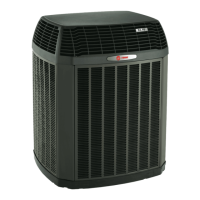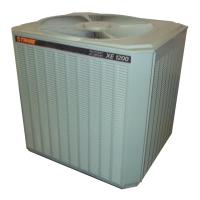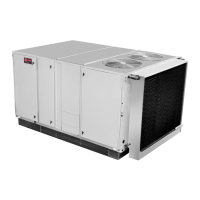Maintenance
OAU-SVX005C-EN 41
Belt Tensions and Adjustments
Belt tension is adjusted during the initial run-in and test
periods at the factory. However, belts are run as slack as
possible to prevent excessive damage to the bearings, yet
tight enough to prevent slippage.
If necessary, tighten all belts during the first few months of
operation, and verify proper tension weekly during the
first 60 days, after which, 30-day check intervals are
sufficient.
Suggested Belt Tension Method
1. Check tension frequently during the first 24 to 48-hours
of run-in operation. Ideal tension is the lowest tension
at which the belt will not slip under peak load
conditions. Over tensioning shortens belt and bearing
life.
2. To properly tension a conventional V-belt drive, use the
following method:
a. Measure the span length.
b. At the center of the span, apply a force
perpendicular to the span to deflect the belt
1/64 inch for every inch of span length. For example:
for a 40-inch span, apply a force that will deflect the
belt 40/64 in. or 5/8 in.
c. Compare the force applied with the values given in
Table 10. If the force is between the values for
normal tension and 1-1/2 times normal tension, the
belt tension should be satisfactory. If the belt
tension is not within this range, it can be adjusted
by loosening the motor mounting bolts and
adjusting the position of the motor along its base.
Note: A new drive can be tightened to two times the
minimum value shown to allow for normal drop in
tension during the run-in period.
Gaskets
Gaskets are used on doors, inspection covers, some filter
racks and some outdoor air dampers. Inspect gaskets
periodically and repair or replace as required.
Annual Maintenance
1. Inspect the tightness of the gas safety shut-off valves
for the furnace by turning off the manual valve
upstream of the appliance combination control.
2. Remove the 1/8 in. pipe plug on the inlet side of the
combination control and connect a manometer to the
tapping.
3. Turn the manual valve ON to apply pressure to the
combination control.
4. Record the pressure reading on the manometer, then
turn the valve OFF.
A loss of pressure indicates a leak. If a leak is detected, use
a soap solution to check all threaded connections. If no leak
is found, the combination control may be faulty and must
be replaced before placing the appliance back in service.
Heater Maintenance
At least a yearly inspection is recommended for heating
installations and more frequently for process applications
in year-round operation. Experience is the best guide in
determining frequency of inspection, but as a minimum,
the following procedure should be followed.
NOTICE:
Motor Failure!
Tightening any belt or belts by changing the pitch of an
adjustable pulley will change the speed of a driven
pulley. This could cause the unit to be rendered out of
air balance which could result in improper unit
operation or motor failure could result.
Table 10. Belt tension specifications
Small pulley diameter range (in.) 3.4–4.2 4.4–4.6 5.8–8.6
Belt manufacturer and belt type Gates Hi-Power
Pounds of force for normal
tension
4.4 4.9 5.8
Pounds of force for 1-1/2 times
normal tension
6.6 7.4 8.7
Note: For recommendations of other belt types, consult respective
manufacturers.
WARNING
Check Gas Tightness of Safety Shut-Off
Valves Annually!
Gas tightness of the safety shut-off valves must be
checked at least on an annual basis. Failure to ensure
gas tightness of the safety shut-off valves could result
in an explosion which could result in death or serious
injury.
AVERTISSEMENT
Vérifiez l’étanchéité au gaz des vannes
d’arrêt de sécurité tous les ans!
L’étanchéité au gaz des vannes d’arrêt de sécurité doit
être vérifiée au moins une fois par an. Le non-respect de
l’obligation de garantir l’étanchéité des vannes d’arrêt
de sécurité peut entraîner une explosion pouvant
résulter en des blessures graves, voire mortelles.
WARNING
Hazardous Voltage!
Failure to disconnect power before servicing could
result in death or serious injury. Disconnect all electric
power, including remote disconnects before servicing.
Follow proper lockout/tagout procedures to ensure the
power can not be inadvertently energized.

